I feel somewhat guilty at my silence so I thought I’d show an example of what I’ve been up to. Keep in mind that the photographs will be big, half the space, some full pagers. It will look a lot better in a photo book.
Each excerpt will be followed by a continuing essay on photography, what it is, what it means, plus a photo essay of my travels, along with short explanatory text. Some of it will be confusing unless you are really paying attention.For better or worse it will not be like any book you’ve come across.
#
1987, 1997 (Excerpted from In Search of Captain Zero)
More than three weeks now since the ferry deposited me and my whole worldly act on the Mexican mainland, and six days since Denise flew down from snowbound Toronto to a quaint little pueblo fronting a reef break I found outside Puerto Vallarta, a move of pure impulsivity after I’d called her from the Mazatlán bullfights and blurted how much I missed her. I caught her going out the door and pictured her in her apartment all bundled up and impatient, but then I could hear the whisper of her coat coming off as she sat down and said she was just thinking about me.
Thing was, when I called her, I was already rattled on some other level, by the bullfight. Although I had experienced one before, I hadn’t at that time seen the connection between it and wave riding, not so much for the grace under pressure aspect—many endeavors involve that—but for how la corrida is likewise a creative interface with an active force of nature. I had been wrong in thinking that surfing was unique in this way. It occurred to me that the essential difference between wave riding and bullfighting lies in the spectacle of the latter. The matador needs the crowd; unlike surfing, the bullfighter’s art is not a strictly personal thing.
These realizations set me to a bout of self-reflection, which so often leads to trouble, as it did here, upon the killing of the first bull. When the matador drove his sword down between the bull’s shoulder blades, through his spinal cord and then into his heart and the animal collapsed in a heap, the focus of my identification switched from man to bull, and I was overcome by a mix of emotions I had felt once before, at sea. And just for a heartbeat as I found myself doubled over in my seat with my eyes shut tight while the rest of the crowd rose and cheered, I also remembered the lust for the kill I myself had felt those years ago.
It was the fall of 1987. I’d gone to sea on a commercial fishing trip out of Montauk with a surfbuddy named Michael Potts and his mate, Dennis Gaviola. We were after big bluefin tuna; individuals are referred to as giants when they weigh in at over 310 pounds. The meat of the giant bluefin is much revered in Japan and is sold as sashimi in restaurants for around $50 an ounce; the succulent, buttery belly meat brings even more.
Giant bluefin tuna are bought off the dock by Japanese exporters who overnight the animals to Tokyo so they can be consumed the next day. The price the local fisherman gets depends on the quality of the meat (the more marbled with fat the better) and the vicissitudes of supply and demand. In the early 1980s, during a time of bluefin scarcity, one big, fine, fatty fish sold “on the hoof” for $80,000. Although this is an extreme example, really big bluefin, known colloquially as “dinosaurs,” routinely bring in five- figure sums.
With this kind of money at stake, the endeavor is very serious business; in lean times a fisherman’s season can be saved with the catching of a single fish. But the giant bluefin is a wily, intelligent animal and the quest for one has more the feel of a big game hunt than “going fishing.” It is not unusual for a boat to go for years without a hook up, let alone a landing. Mike Potts, however, is an extraordinary sea hunter, blessed with an inborn instinct for finding and hooking bluefin that even he can’t explain. He’s known as the best rod-and-reel tuna man in the harbor.
We hooked the fish in question midmorning some 10 miles south of Montauk Light at an exact spot in the ocean that would become known as The Weisbecker Numbers, after its loran coordinates, and since I fought the fish. The fact that Mike had put me in the fighting chair was not a tribute to my experience or ability as a fisherman; quite the contrary. I had in fact never fished for gi
ant bluefin tuna before. The catching of a giant is a complex feat requiring instant and intimate coordination between the skipper on the bridge and the mate on the fish deck. The angler is mostly there for the muscle and is the least important presence in the struggle.
An hour or so into the fight we had coaxed the fish to within a few yards of the boat and I caught my first glimpse of him, a massive spectral flash of silver and blue off the stern. He seemed tired, his pull flaccid and spent. I felt that we had him, that the fight was over. And I was surely glad of that; I was about as physically exhausted as I’d ever been.
But then the rod tip moved subtly sideways as the animal turned his head and saw the boat—saw the human animals on its deck, who were intent on killing him—and then instantaneously I was jerked nearly out of the chair and the rod bent double as he ran for the horizon.
It was another hour before the fish’s runs weakened and we got him close to the boat again; Dennis hopped up onto the transom and raised a harpoon to his shoulder. Then the fish surfaced and I got a good look at him. I was struck not only by his size—he’d go well over a quarter ton—but by the color of his flank, which appeared to pulsate with every hue of blue I’d ever seen—and some I hadn’t, because they were unique to the animal and the situation. They were a reflection, a manifestation, of his will to live, and of the sea itself.
For my part, I had hit a wall of mental and physical exhaustion, and in my lust for the kill my mind was operating on a level of utter here-and-now purity. In a very deep and fundamental way, I wanted that fish to be dead.
But then Dennis’s arm and upper body shot forward and down as he planted the harpoon and at the instant the razor-tipped lance penetrated the fish’s shimmering flank, a jolt ran through my body like a high voltage arc. I also experienced the phenomenon aurally, in the form of a sharp, hallucinated electric crack. And then, as at the bullfight, I found myself bent over, hammered by grief and remorse for the terrible thing being done.
The commotion on deck and the raised voices of my companions and the scream of the reel and the sharp bending of the rod told me something else was wrong. The fish was gone again on a run for the horizon, his fastest and strongest yet. I turned and looked to my left and through the haze of grief and remorse and awe, I watched as Dennis secured a flotation barrel to the quarter-inch nylon harpoon line, which was uncoiling in a blur from the deck. Then the barrel shot off the transom and was gone overboard as if shot from a cannon.
We watched in silence as the barrel plowed horizon-ward, submerging briefly then reappearing as the fish fought its buoyancy. How could this be? I wanted to know. How could this fish could be doing that after two hours of desperate effort fighting the pull of the rod, and now with a harpoon through his back? Dennis turned and looked up at Mike and I knew from their expressions that with all their years of killing big fish they had never seen anything like this before.
We chased the harpooned fish for about another hour; then the barrel ceased its movement through the water and we backed the boat up to it. Dennis reached over the transom and tried to haul in the harpoon line, which was leading straight down now, but he could not do it. He looked up at Mike and shook his head and said that the fish was still green, meaning not ready to be landed. He was just resting, Dennis added.
“No, he’s dead,” I said, and even with all Dennis’s experience, I knew I was right. I had felt the fish’s death rattle, a tiny vibration that had passed up through the monofilament into the rod and then into me.
The heart down there under the water had stopped beating.
With great effort, Mike and Dennis hauled the fish from the depths, then affixed a tail rope, and with block and tackle hoisted the animal over the rail and onto the deck. His electric colors were fading; even as I watched, the beautiful blues of him were gone to a sickly pale. Like the bull in Mexico, he was no longer a force of nature but just a pile of dead meat skewered by a steely lance.
Around sundown, as a Japanese man oversaw the loading of the carcass into a crate with a Tokyo address on the side, I was given a sliver cut from the fish’s massive heart, which I consumed, as is the custom.

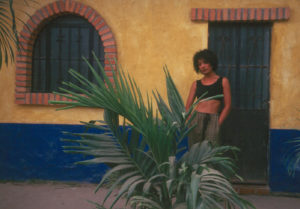
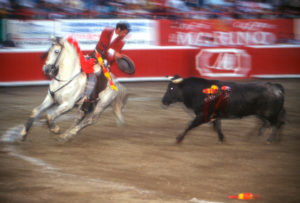
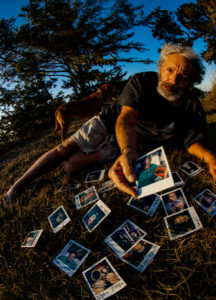
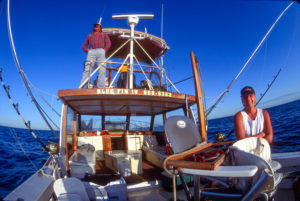
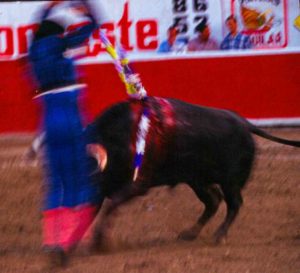
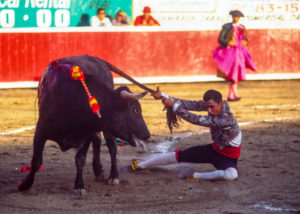
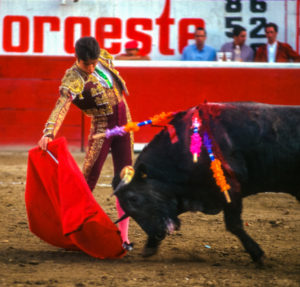
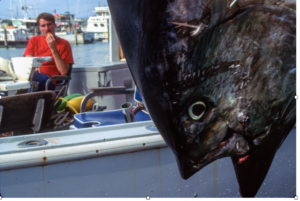
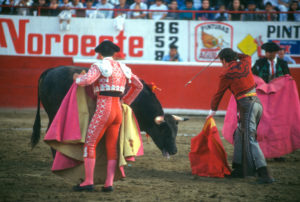
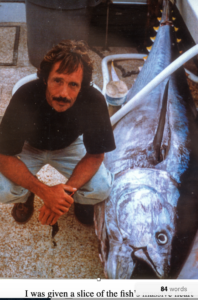
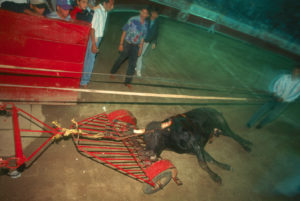
15 comments for “What I’ve Been Doing”